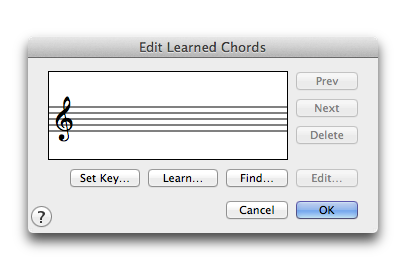

How to get there
- Choose the Chord tool
 . The Chord menu appears.
. The Chord menu appears. - Choose Chord > Edit Learned Chords.
What it does
When you use one of Finale’s three automatic chord analysis methods (MIDI Input, One-Staff Analysis, or Two-Staff Analysis), Finale has no problem identifying most of the common chord types (major, minor, augmented, diminished, half-diminished, suspended, sevenths, ninths, and so on). Each time it encounters a chord for which you’ve created (or loaded in a Chord Suffix library) a chord suffix, it automatically displays the correct chord symbol on the screen, complete with an alternate bass, if necessary.
If Finale encounters a chord for which it can find no predefined suffix, it displays the Unknown Chord Suffix dialog box, giving you two options: "I’ll Do It" or "Let Finale Do It". If you click Let Finale Do It, Finale creates a chord suffix automatically, adds it to the list of chord suffixes for the document, and displays the chord symbol.
If you click "I’ll Do It," however, you have the opportunity of teaching Finale a chord. There are a number of reasons you might want to do so. For example, you might prefer the notation C6 to Finale’s default notation for the same chord (Am7/C). Or you might want Finale to learn a chord by another name—for example, you can teach it to recognize "V11" chords (such as F/G or Dm7/G). You might even want to teach it completely new ways of notating chords that have nothing to do with the usual chord symbol system. See Chord Symbols for a more complete discussion of learned chords.
Once you’ve created a learned chordChords that Finale has analyzed during chord entry that do not match any chord in it's chord suffix library. When Finale encounters a chord it does not recognize, it lets you define it yourself, or Finale makes its "best guess." You can change the definition or spelling of learned chords. or two, however, you may need to edit or delete them. In this dialog box, you can teach Finale another chord, "call up" one that Finale has already learned (to edit it), or delete a learned chord.
- Set Key. Learned chords are scale-degree-specific; if you teach Finale to recognize a C6 chord, it won’t automatically recognize an F6 or a G6 in the same key. But because C6 is built on the root scale tone in the key of C, Finale recognizes a major sixth chord built on the root scale tone in any other key. Therefore, when you teach Finale new chords, you need to indicate the key signature so that Finale knows the context in which it will encounter them. Click this button to display the Key Signature dialog box, which you can scroll to set the key signature for the chord you’re about to teach Finale.
- Learn. Click this button if you want to teach Finale to recognize a new chord. Finale responds by asking you to play the chord on your MIDI keyboard. When you do so, Finale "memorizes" the particular set of notes you played and displays the Chord Definition dialog box, where you can create the chord symbol you want to associate with those notes. Doing so causes Finale to always recognize that chord (regardless of the voicing or octave register) and automatically display the correct symbol provided it encounters the chord on the same scale degree as the one you originally taught it. (For example, if you teach Finale to recognize a C6 in the key of C, it won’t recognize F6 or G6 in the same key. But it will, for example, recognize an A6 in the key of A, because the A6 is built on the same scale degree in A as the C6 was in C.)
- Delete. Click Delete if you want Finale to "forget" the currently displayed learned chord. You won’t remove any chord symbols already in the score by clicking this button—Finale simply won’t recognize the chord the next time it encounters the associated group of pitches.
- Prev • Next. Click Prev or Next to scroll through any learned chords Finale already knows. They appear in the display in the order in which they were created; when you reach the end (or beginning) of the list, the Next (or Prev) button dims.
- Find. Use this button to "call up" any learned chord you’ve already created (so that its symbol appears in the staff display), in order to edit or delete it. When you click the button, Finale displays a message asking you to play the learned chord on your MIDI keyboard. Play it in any voicing and any register, but with the same combination of pitches—and the same bass note—as the learned chord for which you’re searching. Finale responds either by displaying the chord symbol or by telling you that it doesn’t recognize what you played. (At this point it also asks if you want it to learn the chord you just played.)
- Edit. Click this button to display the Chord Definition dialog box, where you can define the visual appearance of the chord symbol in any way you want, such as changing the root, alternate bass, or suffix.
- OK • Cancel. Click OK to return to the score. Click Cancel to disregard any current selections and return to the score.
Noteman says: If you teach Finale a chord it already knows, you’re asked whether or not you want to edit the chord symbol associated with it. If you click Yes, the Chord Definition dialog box is displayed, where you can modify the chord symbol in the usual way.
See also:

